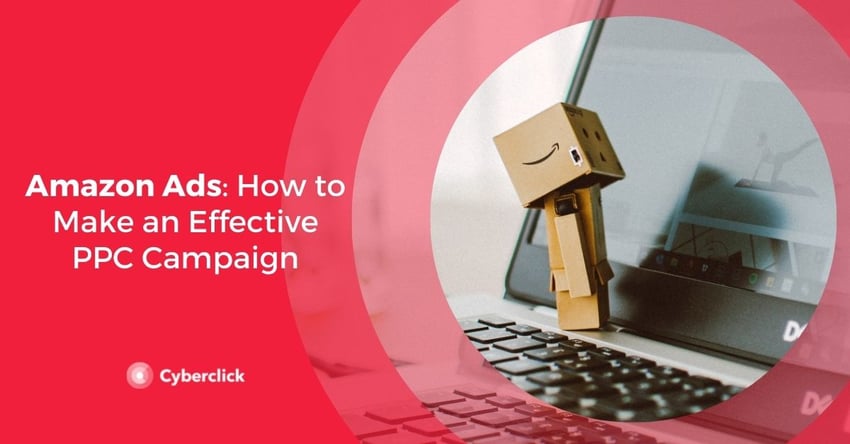Amazon PPC (Pay-per-Click) Ads is a part of Amazon's sophisticated advertising platform that allows sellers to bid on keywords to promote their products in Amazon's search results and product listings. Users access the Amazon platform with an active intent to purchase, making it one of the most interesting digital options available with an impressive database of behavioral information and a real ability to generate sales.
The platform provides various ad formats that cater to an array of advertising needs, such as increasing product visibility, traffic and sales. Choosing the right format, using different match types and selecting the right keywords are some of the tips we will cover in our list of recommendations for an effective Amazon Ads campaign.

As with other PPC ads, Amazon PPC is an advertising model where sellers pay a fee to Amazon when a shopper clicks on their ad. These ads can appear in Amazon search results and on product pages, helping sellers reach customers actively looking to buy, as well as elsewhere on the internet through display advertising.
Creating an effective campaign on Amazon is crucial for advertisers looking to maximize their visibility and sales on one of the world's largest retail platforms. With millions of transactions happening daily, standing out in the Amazon marketplace can be challenging but incredibly rewarding.
How to Choose the Right Type of Ad on Amazon
The first thing you need to know to run an effective PPC campaign on Amazon are the types of ads that exist and their targeting options.
Sponsored Products
These ads promote individual product listings and appear in search results and on product pages, very similar to organic search results on the platform. They are the most prevalent ads on Amazon PPC, with two-thirds of third-party sellers using them.
You can choose the keywords for your sponsored product ads through automatic or manual targeting.
With the automatic option, your ad will appear for the keywords that Amazon's algorithm deems relevant to your product. As the campaign progresses, Amazon improves the targeting based on ad click and purchase data. Your ads will appear when users are searching for keywords related to your product, when they are searching for products similar to yours, and when they are viewing complementary product detail pages.
With the manual strategy, you hand-pick the keywords you want to bid on. Thus, the ad will only appear if a user enters one of the keywords you have chosen. This strategy requires more time and effort but in return it allows you to better customize and control your campaign.
Sponsored Brands
Sponsored brand ads are designed to help users discover brands, and allow marketers to showcase more than one product at a time, attracting attention with more eye-catching creatives.
They generally feature the brand's logo, a headline, and multiple products accompanied by an image or video. They also appear in more prominent positions, such as above or alongside the search results, helping increase brand awareness and recognition. Sponsored Brands tend to be beneficial for sellers looking to promote their brand as a whole rather than specific products.
Sponsored Display
These ads provide the ability to reach customers both on and off Amazon via display advertising. They can appear on Amazon, across other websites on the Amazon Display Network (such as Google, Facebook, Netflix, among many others), and on other Amazon-owned products (Kindle, Amazon Music, etc.). They are particularly useful for remarketing purposes, showing users the products they have previously viewed but nor purchased.
How to Choose Keywords for PPC Campaigns on Amazon
1. Use Different Types of Matches in Your Keywords
As with Google Ads, Amazon ads has different types of keyword matching that allow you to better control when your ads are displayed. Here are the main options available.
-
Broad match: your ads will be displayed for the chosen words and for close variants, such as plurals, acronyms, partial matches, and synonyms.
-
Modified broad match (only for sponsored brand ads) is the same as above, but you can specify the words you want to include in the search term by adding a + in front of them.
-
Phrase matching: your ads will be shown when the search term includes your exact keyword, but may include other words before and after.
-
Exact match: your ads will only be displayed when the user enters the exact keyword in their search.
2. Use Negative Matching
Automated and broad match campaigns can end up displaying your ads on searches that have very little to do with your product or brand.
To avoid this, use negative match to rule out searches that include a particular term or terms to make your ad more relevant. You can choose both phrase and exact negative matches.
3. Incorporate Branded Keywords
Sometimes, the most profitable keyword you can incorporate into your PPC campaigns is your own brand name.
Many advertisers don't use this resource because they think it's a waste of money. After all, if the user is searching for you directly, they are going to find your products anyway.
The problem is that if you don't create campaigns with your brand name, it is possible that your competitors will and their ads will appear before your products, so branded campaigns are a great defensive strategy.
It is also very interesting to include in these campaigns all possible misspellings and alternative ways of writing the name of your brand and your products. This way, you make sure you appear even if the user makes a mistake.
Shanon es una diseñadora multidisciplinaria especializada en la creación de diversos activos digitales, como campañas digitales, videos o ebooks. Con experiencia en marketing digital y inbound marketing, Shanon destaca en el desarrollo de landing pages y webs para clientes usando HubSpot.
Front-End Developer & Graphic Designer. Shanon is a multidisciplinary designer specialized in creating diverse digital assets, including digital ads, videos, ebooks, and more. With a background in digital and inbound marketing, Shanon excels in developing impactful landing and web pages for clients using HubSpot.






Leave your comment and join the conversation